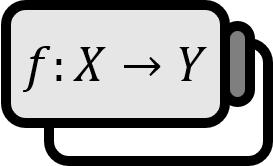감마함수와 팩토리얼이 포함된 여러가지 중요한 공식
공식
$$ \Gamma (\frac{1}{2})=\sqrt{\pi} \tag{a} $$
- 오일러 반사 공식: $$ \Gamma (p)\Gamma (1-p)=\dfrac{\pi}{\sin(\pi p)} \tag{b} $$
$$ \Gamma (n+\frac{1}{2})=\frac{1\cdot 3\cdot \cdot5 \cdots (2n-1)}{2^{n}}\sqrt{\pi}=\frac{(2n-1)!!}{2^n}\sqrt{\pi}=\frac{(2n)!}{4^{n}n!}\sqrt{\pi},\quad n\in \mathbb{N} \tag{c} $$ $!!$는 더블 팩토리얼이다.
- 이항계수: $$ \begin{pmatrix} n \\ k \end{pmatrix}=\frac{\Gamma (n+1)}{k! \Gamma (n-k+1)} \tag{d} $$
- 오일러-마스케로니상수: $$ \gamma=-\Gamma^{\prime} (1) \tag{e} $$
- 베타 함수:
$$ B(p,q)=\frac{\Gamma (p) \Gamma (q)}{\Gamma (p+q)} \tag{f} $$
증명
감마함수: $$ \Gamma (p)=\begin{cases} \displaystyle \int_{0}^\infty x^{p-1}e^{-x}dx & p>0 \\ \frac{1}{p}\Gamma (p+1)& p<0 \end{cases} $$
감마함수의 재귀 공식: $$ \Gamma (p+1)=p\Gamma (p) $$
$(a)$
$(b)$에서 $p=\frac{1}{2}$로 두면 $(a)$를 얻을 수 있지만, 그냥 직접연역해보자. 감마함수의 정의에 의해
$$ \Gamma ({\textstyle \frac{1}{2}})=\int_{0}^{\infty}\frac{1}{\sqrt{x}}e^{-x}dx $$
위 식에서 $x=y^{2}$으로 치환하면 $dx=2ydy$이므로
$$ \Gamma ({\textstyle\frac{1}{2}}) = \int_{0}^{\infty}\frac{1}{y}e^{-y^{2}}2ydy = 2\int_{0}^{\infty}e^{-y^{2}}dy = \int_{-\infty}^{\infty}e^{-y^{2}}dy $$
우변은 가우스 적분이므로
$$ \textstyle \Gamma (\frac{1}{2})=\sqrt{\pi} $$
■
$(b)$
쉽지 않다. 바이어슈트라스의 무한곱과 싱크함수의 오일러 표현을 사용한다.
■
$(c)$
감마함수의 회귀 관계와 $(a)$에 의해서
$$ \begin{align*} \textstyle \Gamma (1+\frac{1}{2}) &= \textstyle \frac{1}{2}\Gamma (\frac{1}{2})=\frac{1}{2}\sqrt{\pi} \\[1em] \textstyle \Gamma (2+\frac{1}{2}) &= \textstyle \frac{3}{2}\Gamma (1+\frac{1}{2})=\frac{3\cdot 1}{2\cdot2}\sqrt{\pi} \\[1em] \textstyle \Gamma (3+\frac{1}{2}) &= \textstyle \frac{5}{2}\Gamma (2+\frac{1}{2})=\frac{5\cdot 3\cdot 1}{2\cdot2 \cdot 2}\sqrt{\pi} \\[1em] \textstyle \Gamma (4+\frac{1}{2}) &= \textstyle \frac{7}{2}\Gamma (3+\frac{1}{2})=\frac{7\cdot 5\cdot 3\cdot 1}{2\cdot 2\cdot2 \cdot 2}\sqrt{\pi} \\ \vdots \\ \textstyle \Gamma (n+\frac{1}{2}) &= \textstyle \frac{(2n-1)(2n-3)\cdots 3\cdot 1}{2^n}\sqrt{\pi} \end{align*} $$
이때
$$ \begin{align*} \frac{(2n-1)(2n-3)\cdots 3\cdot 1}{2^n} &=\frac{{\color{blue}2n}(2n-1){\color{blue}(2n-2)}(2n-3){\color{blue}(2n-4)}\cdots {\color{blue}4}\cdot 3\cdot {\color{blue}2}\cdot 1}{2^n {\color{blue}2n(2n-2)(2n-4)\cdots 4\cdot 2}} \\ &=\frac{(2n)!}{2^n 2^n n(n-1)(n-2)\cdots 2\cdot 1} \\ &=\frac{(2n)!}{4^n (n)!} \end{align*} $$
이므로
$$ \Gamma (n+{\textstyle\frac{1}{2}})=\frac{1\cdot 3\cdot \cdot5 \cdots (2n-1)}{2^{n}}\sqrt{\pi}=\frac{(2n-1)!!}{2^n}\sqrt{\pi}=\frac{(2n)!}{4^{n}n!}\sqrt{\pi} $$
■
$(d)$
$$ \begin{pmatrix} n \\ k \end{pmatrix} = \frac{ n! }{ k!(n-k)! }=\frac{ \Gamma (n+1) }{ k! \Gamma (n-k+1)! } $$
$\Gamma (n+1)=n!$임을 이용하면 한 줄에 끝난다.
■
$(e)$
■
$(f)$
■

 저희들의 저서 「줄리아 프로그래밍」이 2024 세종도서 학술부문에 선정되었습니다!
저희들의 저서 「줄리아 프로그래밍」이 2024 세종도서 학술부문에 선정되었습니다!

